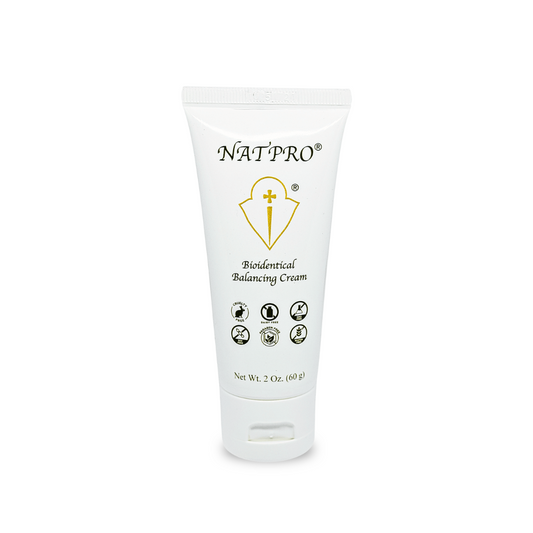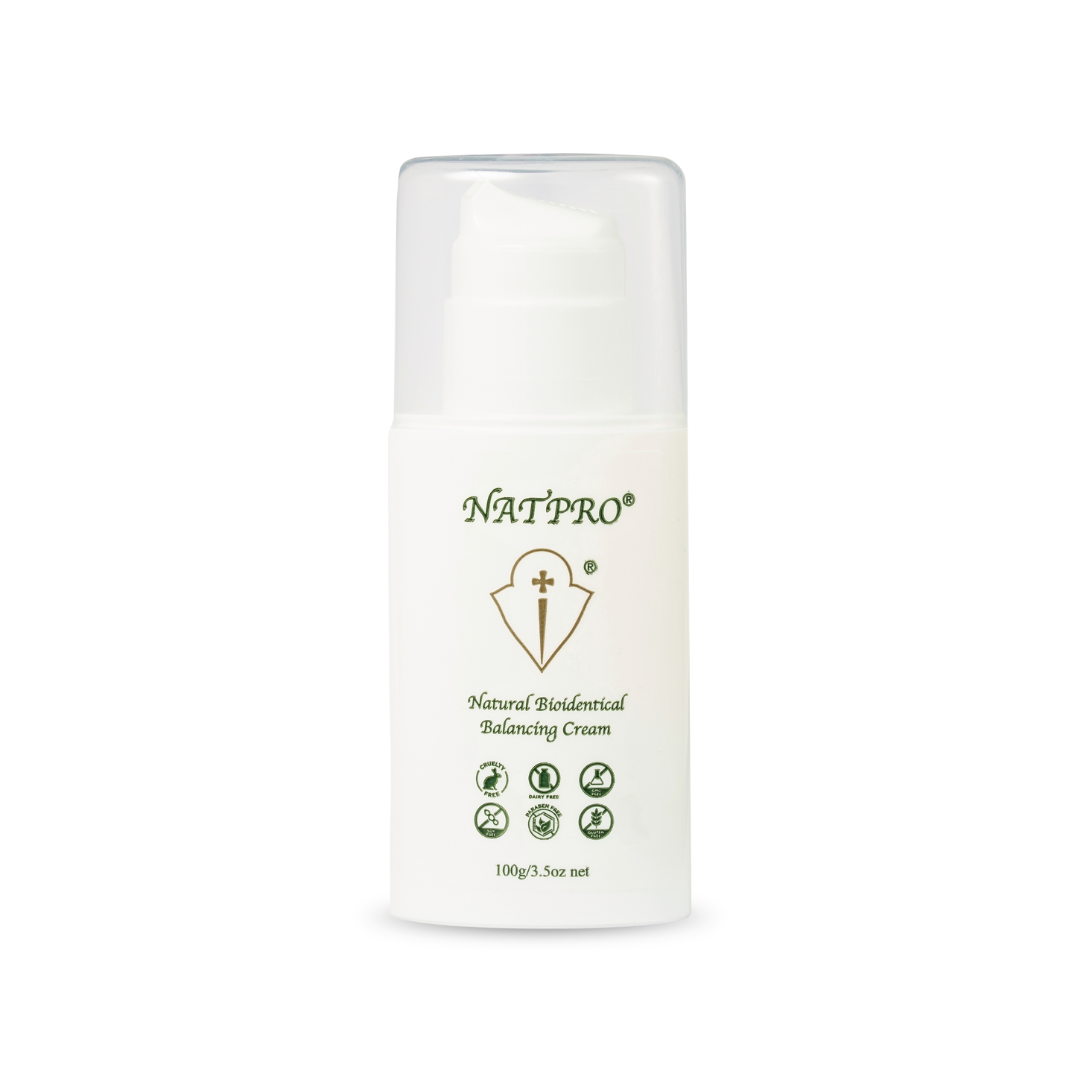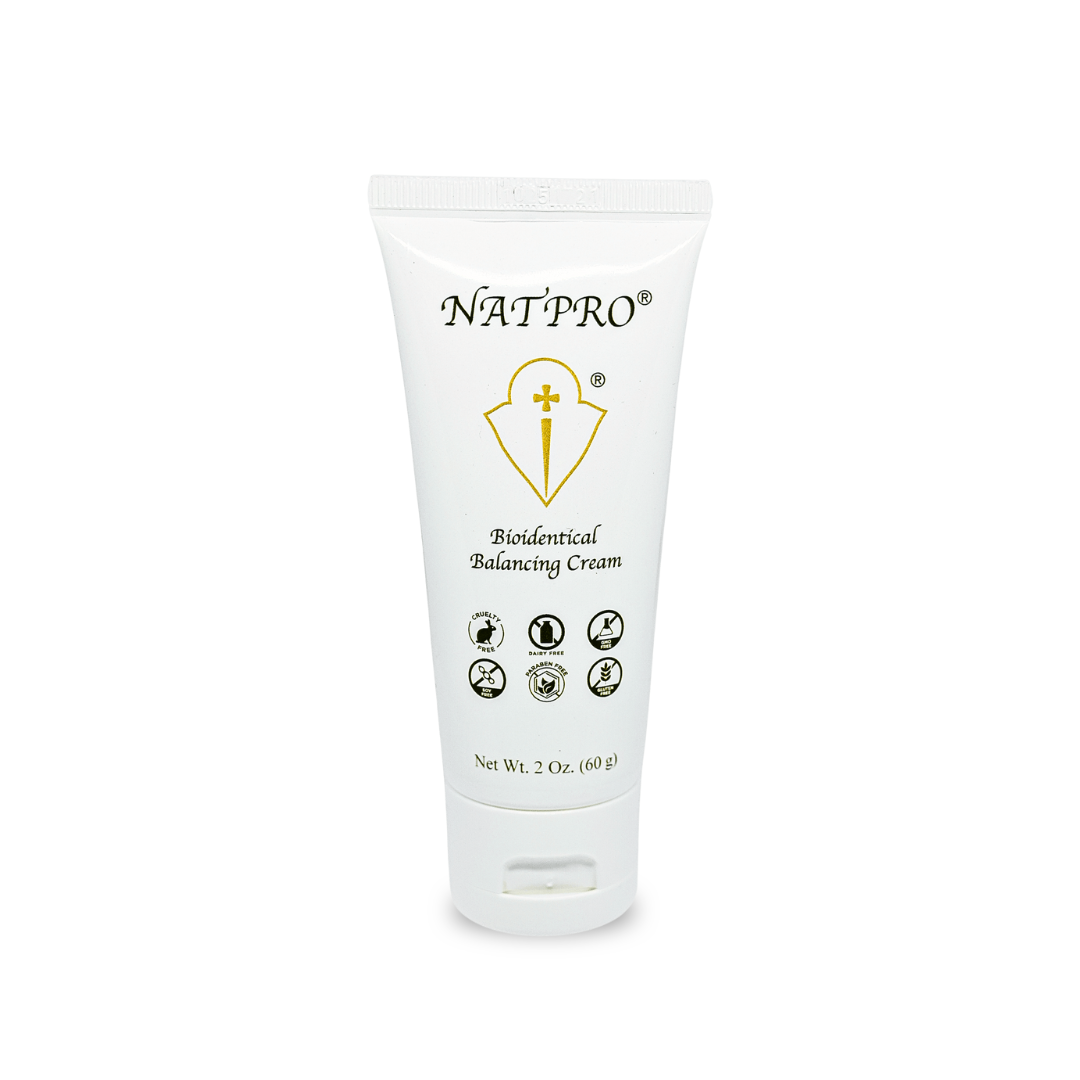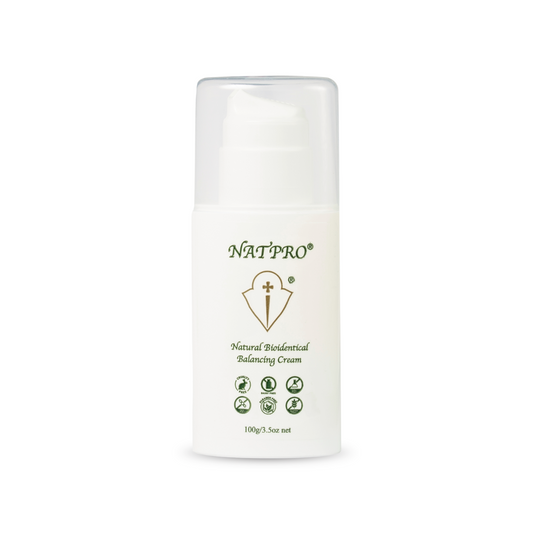
Natpro
All natural, bio-identical progesterone cream
Featured products
-
Natpro Dispenser
Regular price $42.90 USDRegular price -
 Sold out
Sold outNatpro Tube
Regular price $25.70 USDRegular price
Natpro Facts..
USP progesterone
- The progesterone in Natpro is identical to the progesterone your body makes.
- The USP progesterone in Natpro is derived from the Mexican Wild Yam. Don't confuse Natpro progesterone cream with a bean or yam "extract". Such extracts do not contain progesterone.
- Natpro has a progesterone concentration of 3.33%. This means there are 33.33 milligrams of progesterone per gram of cream.
PEG free
PEG stands for polyethylene glyco. It’s found in many formulas and has been causing some concern in recent times as a potential health hazard.
Paraben free
We use Aspen bark extract as a natural organic preservative. It is an effective replacement for commonly used chemical preservatives such as the parabens.
Soy, gluten & dairy free
- The USP progesterone in Natpro is derived from the Mexican Wild Yam not Soy.
(Don't confuse Natpro progesterone cream with a wild yam extract cream. Such creams do not contain progesterone.)
- There is no gluten or dairy used in our formula.
GMO free
We do not use any genetically modified ingredients in our Natpro formula.
Cruelty free
No animal has suffered or will ever suffer because of Natpro production.

How to use: Natpro Dispenser
1 pump of Natpro cream from the dispenser gives you 50 mg of progesterone
Recommended basic daily dose between:
2 pumps Natpro cream = 100mg progesterone
and
4 pumps Natpro cream = 200mg progesterone
•Use half the dose in the morning and half in the evening•
Use between 100 - 200mg initially to achieve balance and then settle to a dose that works for your body.
For more severe symptoms increase the dose to 400 - 600mg until symptoms resolve. Reduce the dose slowly once severe symptoms have resolved.

How to use: Natpro Tube
1tsp (5ml or 5 grams) of Natpro cream gives you 166mg of progesterone.
Recommended basic daily dose between:
3ml or 3g of Natpro cream = 100mg progesterone
&
6ml or 6g of Natpro cream = 200mg progesterone
•Use half the dose in the morning and half in the evening•
Use between 100 - 200mg initially to achieve balance and then settle to a dose that works for your body.
For more severe symptoms increase the dose to 400 - 600mg until symptoms resolve. Reduce the dose slowly once severe symptoms have resolved.
How to use Natpro for:
Pre-pubertal phase
It's given to pre-term male and female infants with respiratory distress syndrome. It's effective for calming, and for any sleep issues in babies and children. Babies have been bathed in it for 9 months of their lives prior to birth.
Natural progesterone is the only hormone that does not adversely affect a male or female baby or child. So if some should rub off an adult using it, no harm will come. Unlike testosterone or oestrogen, which cause serious side effects in a male or female baby or child.
If progesterone is used on an infant or child be strict about the dose used:
1mg of progesterone or a pin head amount of cream can be applied to infants,
Older children use 5-10mg.
It only needs to be used for easing the child over a rough patch.
It helps with adverse symptoms experienced prior to puberty, and any found while going through puberty.
You are encouraged to refer any health problem to a health care practitioner and, in reference to any information contained in this web site, preferably one with specific
knowledge of progesterone therapy.
Menarche
Menstruation starts about two years after puberty begins and is known as menarche.
These two years can bring mood swings, temper tantrums, defiant behaviour, skin outbreaks and more. Oestrogen and testosterone levels are rising, but it's not until menarche occurs and with it ovulation, does progesterone production begin.
100-200mg/day progesterone should be used, dependant on symptoms.
Apply half the dose in the morning and half in the evening to maintain levels.
As there is no cycle to follow the progesterone can be applied daily until a cycle starts.
Once symptoms have passed the amount can be reduced very slowly. As a guide reduce by 20mg per week allowing time for your body to adjust to the new level. Reduce the does only until the optimum dose for your body is found -which is when you can maintain a dose and not experience adverse symptoms.
If you do not reduce slowly over a few weeks adverse symptoms may return. If they do you will need to increase the dose incrementally again by 20mg until you find the dose that stabilises symptoms.
A progesterone cream can be used anywhere on the body, it does not have
to be applied to the thin skinned areas only. The skin comprises 95% kerotinocytes, these have ample progesterone receptor sites.
You are encouraged to refer any health problem to a health care practitioner and, in reference to any information contained in this web site, preferably one with specific
knowledge of progesterone therapy.
Heavy / continual bleeding
It is essential to use a high amount of progesterone if menorrhagia or excessive, continual bleeding is a problem.
Between 400-600mg/day is normally needed. If the bleeding is continual, use it
both daily and hourly. Using it hourly keeps the level high throughout the day.
If there is a menstruation cycle, it is best to ignore it and use the progesterone daily, hourly too, until the bleeding is under control. The progesterone can be used to regulate the cycle once bleeding has stopped.
You should expect to see results in 4 - 7 days on the high dose though sometimes it may take longer.
Once symptoms have eased the amount can be reduced very slowly. Whenever you reduce the dose, always do so slowly over a few weeks to negate symptoms flaring up again. As a guide reduce by 20mg per week. Reducing slowly allows your body to calibrate gently - giving you time to register the changes and how your body is responding to the current dose.
If you do not reduce slowly over a few weeks adverse symptoms may return. If they do you will need to increase the dose incrementally again by 20mg until you find the dose that stabilises symptoms.
A progesterone cream can be used anywhere on the body, it does not have
to be applied to the thin skinned areas only. The skin comprises 95% kerotinocytes, these have ample progesterone receptor sites.
If the heavy bleeding occurs during Peri-menopause, the progesterone will stop it, but will not regulate the cycle again.
Women are often given progestins to stop the bleeding, but these suppress progesterone production and come with adverse side effects, please see our page on Contraceptives.
Supporting factors:
The amino acid N-acetyl cysteine is a powerful antioxidant, which can help control the bleeding as it inhibits matrix metalloproteinases. Consider taking 2000mg/day. Start taking 500mg/day and then slowly work up to 2000mg/day over one or two weeks to allow your body to adjust.
Vitamin D is essential for the normal functioning of all cells, and to prevent early commencement of the menstruation cycle. Have a blood test done to check the level. For more information visit:
Blood levels should be 70-100ng/ml or 175-250nmol/L and not the 30ng/ml or 75nmol/L most labs and doctors regard as adequate. The minimum daily dose should be 5000iu's per day, although the latest research indicates it should be 10,000iu's per day, see here.
Taurine is another powerful antioxidant. Low levels have been found in women with endometrial cancer, cystic endometrial hyperplasia, fibromyoma (fibroids), and dysfunctional uterine bleeding. Consider taking 2000mg/day.
Bioflavonoids have been found to strengthen capillaries. They appear to be weakened in heavy and/or continual bleeding or spotting. The preparation that was used in the study
comprised 90% diosmin and 10% hesperidin. Consider taking 1000mg/day.
Complete Heavy Bleeding Protocol:
- 400-600mg Natpro per day
- 2000mg N-Acetyl-Cysteine (NAC) per day
- 2000mg Taurine per day
- 5000iu's Vitamin D3 per day
- 1000mg Bioflavanoids per day
You are encouraged to refer any health problem to a health care practitioner and, in reference to any information contained in this website, preferably one with specific
knowledge of progesterone therapy
Reproductive phase
This lasts from menarche to peri-menopause when fertility starts to drop.
A normal cycle length varies from 21 days to 35 days, 28 days being the average. This is the reason that manufacturers of Contraceptives and HRT pack their product in twenty eight day batches.
Cycles outside this range are generally regarded as abnormal. For more information on this see our pages on Menstruation and PCOS.
All women, irrespective of their cycle length, ovulate 12-14 days before bleeding.
This phase of the cycle is known as the luteal or secretory phase.
Progesterone should be used during the luteal phase, ie from ovulation to bleeding, to supplement any deficiency.
The deficiency can be caused by a defective luteal phase, or anovulatory cycles. These begin round about age 35, which is when many women find their PMS symptoms become worse.
100-200mg/day progesterone should be used, more if symptoms are severe.
Use half the does in the morning and half in the evening.
A progesterone cream can be used anywhere on the body, it does not have
to be applied to the thin skinned areas only. The skin comprises 95% kerotinocytes, these have ample progesterone receptor sites.
Normal Cycle Lengths: Everyone, including the medical profession, assumes a normal cycle length is always 28 days in all women. This is simply not the case.
It varies between 21 to 35 days, which makes 28 days the average only.
There is a fundamental error in advising women to start using progesterone on day 14. This is only appropriate for women with a 28 day cycle.
If a woman has a 21 day cycle, starting on day 14 would mean she starts using progesterone a week after ovulation. She would then only use progesterone for 7 days before bleeding began.
Likewise a woman with a 35 day cycle would begin progesterone a week before ovulation,
which would effectively stop it. She would then use progesterone for 21 days.
Progesterone should always be used from ovulation, for the last 12-14 days of the cycle.
Or if wishing to fall pregnant, it can be started during the 50 hour surge which occurs prior to ovulation.
Progesterone can be used while on drug based Contraceptives. It should be used when taking the second half of the packet.
Progesterone is safe to use with any drug, there are no contraindications.
Once symptoms have passed the amount can be reduced very slowly. As a guide reduce by 20mg per week allowing time for your body to adjust to the new level. Reduce the does only until the optimum dose for your body is found -which is when you can maintain a dose and not experience adverse symptoms.
If you do not reduce slowly over a few weeks adverse symptoms may return. If they do you will need to increase the dose incrementally again by 20mg until you find the dose that stabilises symptoms.
For more in depth information visit our page FAQ conception and Menstrual cycle.
You are encouraged to refer any health problem to a health care practitioner and, in reference to any information contained in this web site, preferably one with specific
knowledge of progesterone therapy
Peri-menopause
Peri menopause is a time when progesterone is vital for well being. Levels start dropping from the age of thirty five, due to the increased frequency of anovulatory cycles, whereas estrogen remains at normal levels until menopause, when they drop sharply.
Roughly one to two years prior to menopause menstrual cycles can become very erratic. Every two weeks, or at three month intervals, there is no telling when bleeding will occur. This can vary from spotting, to a normal period, to flooding.
100-200mg/day progesterone should be used daily.
Use half the dose in the morning and half in the evening to maintain levels.
If symptoms are severe you can increase the dose to between 400 - 500mg/day. You should expect to see results in 4 - 7 days on the high dose though sometimes it may take longer.
Once symptoms have eased the amount can be reduced. Whenever you reduce the dose, always do so slowly over a few weeks to negate symptoms flaring up again. As a guide reduce by 20mg per week. Reducing slowly allows your body to calibrate gently - giving you time to register the changes and how your body is responding to the current dose.
If you do not reduce slowly over a few weeks adverse symptoms may return. If they do you will need to increase the dose incrementally again by 20mg until you find the dose that stabilises symptoms.
Once cycles become erratic, and impossible to follow, it is best to stop following the cycle and use progesterone daily, through any bleeding. It is safe to do so. For more information see Progesterone misconceptions.
A progesterone cream can be used anywhere on the body, it does not have
to be applied to the thin skinned areas only. The skin comprises 95% kerotinocytes, these have ample progesterone receptor sites.
For more in-depth information visit our peri-menopause page.
You are encouraged to refer any health problem to a health care practitioner and, in reference to any information contained in this web site, preferably one with specific
knowledge of progesterone therapy.
Menopause
This begins on average at age 51. It's normal to wait a year before judging menopause has begun. Many women think their problems will be over once in menopause, but this is often not the case.
Ovulation has now ceased, ovarian production of progesterone and oestrogen has stopped. But fat cells continue secreting oestrone, the menopause oestrogen, until death.
Unfortunately there is no compensatory secretion of progesterone.
Many women have their oestrogen levels tested and are told it is low. But it's oestradiol which is tested for, the pre-menopause oestrogen, never oestrone, the oestrogen secreted from menopause onwards.
Oestradiol should be low, it varies from 0-30pg/ml (0 - 110.13 pmol/L), see our page on Hormone Testing for more information.
100-200mg/day progesterone should be used daily.
Use half the dose in the morning and half in the evening to maintain levels.
If symptoms are severe increase the dose to between 400 - 500mg/day. You should expect to see results in 4 - 7 days on the high dose though sometimes it may take longer.
Once symptoms have eased the amount can be reduced very slowly. As a guide reduce by 20mg per week allowing time for your body to adjust to the new level. Reduce the does only until the optimum dose for your body is found -which is when you can maintain a dose and not experience adverse symptoms.
If you do not reduce slowly over a few weeks adverse symptoms may return. If they do you will need to increase the dose incrementally again by 20mg until you find the dose that stabilises symptoms.
As there is no cycle to follow, use progesterone daily. Many women are
advised to take a break, but it is not necessary. For more information see Progesterone misconceptions.
Ironically no caution is given to women who take HRT continually.
Women who begin using progesterone for the first time once in menopause can experience one period, rarely two. This is nothing to be alarmed about. Over the course of the proceeding months or years the small amount of estrogen being secreted by fat cells is enough to build or thicken the lining. The progesterone is effectively cleaning out the uterus.
The bleeding more often than not occurs within the first year of menopause, but it has been known for women 12 years into menopause to have a period when first using progesterone.
A progesterone cream can be used anywhere on the body, it does not have
to be applied to the thin skinned areas only. The skin comprises 95% kerotinocytes, these have ample progesterone receptor sites.
For more in-depth information visit our menopause page.
You are encouraged to refer any health problem to a health care practitioner and, in reference to any information contained in this web site, preferably one with specific
knowledge of progesterone therapy.
Post-menopause
Post menopausal women have naturally low progesterone levels and are still subjected to the same endocrine disruptors as everyone else, further increasing estrogen levels and contributing to adverse symptoms.
100-200mg/day progesterone should be used daily.
Use half the dose in the morning and half in the evening to maintain levels.
If symptoms are severe increase the dose to between 400 - 500mg/day. You should expect to see results in 4 - 7 days on the high dose though sometimes it may take longer.
Once symptoms have eased the amount can be reduced. Whenever you reduce the dose, always do so slowly over a few weeks to negate symptoms flaring up again. As a guide reduce by 20mg per week. Reducing slowly allows your body to calibrate gently - giving you time to register the changes and how your body is responding to the current dose.
If you do not reduce slowly over a few weeks adverse symptoms may return. If they do you will need to increase the dose incrementally again by 20mg until you find the dose that stabilises symptoms.
If you have just started using progesterone it has been known for women 12 years into menopause to have a period when first using progesterone. This is nothing to be alarmed about. Over the course of the proceeding months or years the small amount of estrogen being secreted by fat cells is enough to build or thicken the uterine lining. The progesterone is effectively cleaning out the uterus.
If you are experiencing spotting and you are post menopausal seek medical care to rule out pathology.
If there is no pathological reason found, use between 100 - 200mg/day to help with the spotting.
Increase the dose to 400mg if needed and maintain this for 4-6 days before reducing the dose very slowly over the course of a few weeks until you find a dose that manages your symptoms effectively.
A progesterone cream can be used anywhere on the body, it does not have
to be applied to the thin skinned areas only. The skin comprises 95% kerotinocytes, these have ample progesterone receptor sites.
For more in-depth information visit our page Progesterone Therapy.
You are encouraged to refer any health problem to a health care practitioner and, in reference to any information contained in this web site, preferably one with specific
knowledge of progesterone therapy.
Hysterectomy
By removal of the uterus and possibly the ovaries, a woman goes into instant menopause. If the ovaries are not removed at the same time as the uterus, they will generally atrophy within two to three years.
In the recent past, following a hysterectomy, women were usually given HRT. However, with the publication of studies finalized in 2004, which proved beyond doubt that HRT can cause an increase in cancer (particularly breast cancer), stroke and heart disease, this practice has declined. Unfortunately few medical practitioners recommend progesterone regardless of the clear connection between progesterone and menopause.
100-200mg/day progesterone should be used daily.
Use half the dose in the morning and half in the evening to maintain levels.
If symptoms are severe increase the dose to between 400 - 500mg/day. You should expect to see results in 4 - 7 days on the high dose though sometimes it may take longer.
Once symptoms have eased the amount can be reduced. Whenever you reduce the dose, always do so slowly over a few weeks to negate symptoms flaring up again. As a guide reduce by 20mg per week. Reducing slowly allows your body to calibrate gently - giving you time to register the changes and how your body is responding to the current dose.
If you do not reduce slowly over a few weeks adverse symptoms may return. If they do you will need to increase the dose incrementally again by 20mg until you find the dose that stabilises symptoms.
As there is no cycle to follow, use progesterone daily. Many women are
advised to take a break, but it's not necessary. For more information see Progesterone misconceptions.
Ironically no caution is given to women who take HRT continually.
A progesterone cream can be used anywhere on the body, it does not have
to be applied to the thin skinned areas only. The skin comprises 95% kerotinocytes, these have ample progesterone receptor sites.
You are encouraged to refer any health problem to a health care practitioner and, in reference to any information contained in this web site, preferably one with specific
knowledge of progesterone therapy.
Hot Flashes
Under normal circumstances, women require 100-200mg/day progesterone, unless symptoms are severe.
Hot flushes, once started, only respond to levels of 400mg/day and over.
For severe hot flushes use 400 - 600mg progesterone per day. You should expect to see results in 4 - 7 days on the high dose though sometimes it may take longer.
Once symptoms have eased the amount can be reduced. Whenever you reduce the dose, always do so slowly over a few weeks to negate symptoms flaring up again. As a guide reduce by 20mg per week. Reducing slowly allows your body to calibrate gently - giving you time to register the changes and how your body is responding to the current dose.
If you do not reduce slowly over a few weeks adverse symptoms may return. If they do you will need to increase the dose incrementally again by 20mg until you find the dose that stabilises symptoms.
Men generally need 10-100mg/day progesterone, but 100mg/day and over will be needed to stop hot flushes.
A progesterone cream can be used anywhere on the body, it does not have
to be applied to the thin skinned areas only. The skin comprises 95% kerotinocytes, these have ample progesterone receptor sites.
For more informaiton see our page Cure for Hot Flushes
You are encouraged to refer any health problem to a health care practitioner and, in reference to any information contained in this web site, preferably one with specific
knowledge of progesterone therapy.
PCOS
A lack of vitamin D is found in PCO, with many authorities believing it could be the main contributing factor. A lack also leads to hyperparathyroidism which is often present in PCO. High levels of parathyroid hormone suppresses thyroid activity, leading to a higher than normal TSH level. The year round level of vitamin D should be 50ng/ml (125nmol/L) or higher.
Take a minimum of 5000 IU's Vitamin D per day, bringing the level in the blood to 50ng/ml (125nmol/L) or above.
Use between 150-250mg of progesterone per day
It should only be used at ovulation, for the last 14 days of the cycle, taking day 1 as the first day of bleeding.
Cycles can be very erratic or non-existent in PCO, if this is the case use a 28 day cycle to begin with, until the natural cycle exerts itself. This would mean using the cream from day 15 to 28. For more information please see this web page on how to use progesterone.
If symptoms are severe, please consider using the progesterone daily, through any bleeding that might occur. Do this for at least 3 months, before following the cycle once again. A scan will confirm if the cysts are being absorbed back into the body.
If after the 3 months the scan confirms the cysts are going, a cycle can be started using the progesterone following a 28 day cycle. This should prevent any further cysts developing and hopefully initiate ovulation.
If there is a cycle, but with spotting before a full period, between 200-250mg of progesterone will be needed during the last 14 days to prevent the spotting. The spotting is a sign that the progesterone level is dropping too low, too soon, to support the
endometrium.
Stress drops progesterone levels sharply so symptoms come back. Increase the amount used if stress should occur.
A progesterone cream can be used anywhere on the body, it does not have
to be applied to the thin skinned areas only. The skin comprises 95% kerotinocytes, these have ample progesterone receptor sites.
It's essential to take the necessary antioxidants, L-arginine and N-acetyl cysteine too. Take 500mg of each per day. Studies have shown these antioxidant amino acids restore gonadal function. Consult with your healthcare provider to establish
You are encouraged to refer any health problem to a health care practitioner and, in reference to any information contained in this web site, preferably one with specific
knowledge of progesterone therapy.
Breast cysts
The amount of progesterone will be dependent on the individual and the
severity of the problem.
Between 100-200mg/day of progesterone should be used.
In severe cases use 400 - 500mg/ day.
Use half the dose in the morning and half in the evening
Apply the progesterone cream directly to the breasts.
When dealing with breast cysts it's essential to keep dopamine levels up to inhibit prolactin production. Adding more protein to your diet will assist. Alternatively take 250mg/day tyrosine in the morning. This requires vitamin B3 and folic acid for conversion, so take 100mg B3 and 300mcg folic acid. Gradually increase the tyrosine dose until the optimum is found. It is safe to go up to 6000mg/day. There's no need to increase the B vitamins.
Excess oestrogen can also be reduced by Calcium D-glucarate. Oestrogen is metabolised in the liver by glucuronic acid, the process is known as 'glucuronidation'. The process also removes other substances, including toxins, drugs, bilirubin, androgens, mineralocorticoids and glucocorticoids.
It is then excreted in the bile, but an enzyme in the intestine called beta-glucuronidase breaks the oestrogen/glucuronide bond, which allows oestrogen to be reabsorbed. There's evidence beta-glucuronidase activity is increased in breast and prostate cancer. Calcium D-glucarate inhibits beta-glucuronidase. See here and here.
Another supplement worth taking is DIM(diindolylmethane). Oestrogen is broken down into two principle metabolites, 2-hydroxyestrone (2-OHE1) and 16-alpha hydroxyestrone (16alpha-OHE1).
16alpha-OHE1 is regarded as a potent oestrogen, whereas 2-OHE1 is a weak oestrogen. DIM increases levels of 2-OHE1, by doing so it also increases the ratio of 2-OHE1:16alpha-OHE1. This increased ratio is
associated with a lower risk for breast cancer.
Check for an iodine deficiency, and if found take chelated iodine or Lugol's Iodine. You can also rub the Lugol's Iodine directly onto the breast.
You are encouraged to refer any health problem to a health care practitioner and, in reference to any information contained in this web site, preferably one with specific
knowledge of progesterone therapy.
Ovarian Cysts
Ovarian cysts are abnormal sacs filled with liquid or semi-solid matter found in the ovary. They can vary in size from one or two centimetres to ten or more centimetres.
Almost all pre-menopausal women will have them at some time or another, but only about 15% of menopausal women experience them.
Cysts can occur as a result of excessive stimulation by follicle stimulating hormone (FSH), or luteinising hormone (LH), or a sensitivity to these gonadotrophins.
To address this imbalance progesterone is essential, so are vitamin D and other
antioxidants. The cyst/s are normally reabsorbed within three to six months, with continued use of progesterone and antioxidants they will not return.
Use between 100-200mg/day of progesterone, half the dose in the morning, half in the evening.
You can choose to use the progesterone with your cycle if you are still menstruating or you can use the progesterone daily and not follow your cycle to neutralise the imbalance and cysts more rapidly.
A progesterone cream can be used anywhere on the body, it does not have
to be applied to the thin skinned areas only. The skin comprises 95% kerotinocytes, these have ample progesterone receptor sites.
Vitamin D is essential for normal ovarian function, in particular ovulation. A lack is behind oxidative stress, PCOS and it reduces the benefits of progesterone. A test should be done to check blood levels and a minimum of 5000iu's per day should be taken. Consider taking 1600mg/day arginine and 1200mg/day cysteine. Both these amino acids are potent antioxidants.
For more information see our page on Ovarian Cysts.
You are encouraged to refer any health problem to a health care practitioner and, in reference to any information contained in this web site, preferably one with specific
knowledge of progesterone therapy.
Extremely stressful situations
Extreme cases of stress can be short lived or prolonged.
Using progesterone to help you manage stress requires personal and situation specific application.
If you are already using the basic recommended dose of 100-200mg/day of progesterone you will need to increase the dose up to 400 - 600mg/day during the stressful period. Once the cause of stress has passed reduce the amount slowly over a few weeks to your regular dose.
If you are coming to progesterone therapy for the first time to find relief from the effects of extreme stress start on 100 - 200mg/day and gradually increase the dose over a week to two weeks until you reach a dose that stabilises your symptoms. You may need to go up to 600mg/day. Maintain this dose until the stressful situation has neutralised, then gradually reduce the dose. If symptoms return increase the dose again.
Always split the dose up. Apply half the dose in the morning and half in the evening to maintain levels.
Alternatively you can choose to split the dose further and apply it four times a day or hourly depending of the severity of your situation.
Whenever you reduce the dose, always do so slowly over a few weeks to negate symptoms flaring up again. As a guide reduce by 20mg per week. Reducing slowly allows your body to calibrate gently - giving you time to register the changes and how your body is responding to the current dose.
If you are menstruating and going through an extremely stressful situation you can use the progesterone daily without following your cycle until the stressful period has subsided.This may disrupt your cycle but it will return to normal once you start using the progesterone with your cycle again (during the luteal phase).
A progesterone cream can be used anywhere on the body, it does not have
to be applied to the thin skinned areas only. The skin comprises 95% kerotinocytes, these have ample progesterone receptor sites.
You are encouraged to refer any health problem to a health care practitioner and, in reference to any information contained in this web site, preferably one with specific
knowledge of progesterone therapy.
Men
Using progesterone is easy as there is no cycle to follow, it can therefore be applied daily.
It's best to apply it twice a day and more frequently if symptoms are severe.
Use between 10-100mg/day progesterone, more if severe symptoms are experienced.
Levels over 1200mg/day are given to men who have suffered a Traumatic Brain Injury.
Men secrete <3.18 nmol/L (<1 ng/ml) progesterone daily.
A progesterone cream can be used anywhere on the body, it does not have
to be applied to the thin skinned areas only. The skin comprises 95% kerotinocytes, these have ample progesterone receptor sites.
You are encouraged to refer any health problem to a health care practitioner and, in reference to any information contained in this web site, preferably one with specific
knowledge of progesterone therapy.
Please note...
-

No less than 3 months
Initially Natpro should be used for no less than three months to start feeling the benefits. Some bodies respond quicker and some take longer.
Using natural methods such as supplementing with bio-identical progesterone takes time and perseverance.
Much also depends on other influencing factors such as your environmental circumstances, diet, exercise, the personal and home care products you use and stress levels.
Many people give up before they have allowed the body enough time to adjust as we are so conditioned to expecting instant results.
Using enough bio-identical progesterone and using it correctly is essential to allow your body enough time to adjust. -

Estrogen dominance and environmental toxins
One of the functions of progesterone is to balance the estrogen in the body. If your system is being bombarded by excessive environmental estrogenic mimics, supplementing with progesterone can help alleviate the adverse symptoms associated with excess estrogen.
Be it from oestrogen mimics, normally called endocrine disrupting chemicals (EDC's), endogenous oestrogen or phytoestrogens from plants, the usually recommended 20 -40mg dose is not sufficient for this purpose initially as it only serves to stimulate estrogen.
Micronized progesterone regulation of the endometrial glandular cycling pool
Researchers are linking the rise in hormone related diseases to environmental toxins such as synthetic chemicals, especially pesticides which mimic the female hormone oestrogen. In particular these include DDT, dioxin and PCB's (polychlorinated biphenyls).
Implication of environmental estrogens on breast cancer treatment and progression
Endocrine disruptors: from Wingspread to environmental developmental biology
Endocrine-Disrupting Chemicals
State of the science of endocrine disrupting chemicals
Over 100 chemicals have now been identified as hormone disrupters, at least half of which resist the natural processes of decay, some persisting for decades, some for centuries. Approximately 2 billion tons of pesticides and countless billions of tonnes of industrial chemicals are used annually the world over.Visit the EWG database to check the ingredients of your personal care and household products.
-

Other factors
Progesterone will help if the problem is caused by a lack of it or if excess estrogen is present, but there are many other factors involved too, for instance a lack of vitamin D reduces the benefits of progesterone, please have a test done. The optimal range is between 70-100ng/mL. Nothing less than 5,000iu's is needed daily. Co-factors are needed when taking D3, magnesium and vitamin K2 are the important ones.
Large meals, dark gloomy days, winter, high adrenaline levels, excess blood glucose, a high amount of phytoestrogens in the diet, HRT and the contraceptive pill, all affect your levels adversely.
Stress drops progesterone levels drastically too, if you go through a very stressful period increase your progesterone dose to maintain levels. Practicing mindfulness techniques can contribute to managing stress levels.
Where possible eat a nutrient rich diet and stay away from processed foods and synthetic chemicals. Diet and nutrition are primary areas to focus on before choosing to supplement with anything. Eating foods that support your gut health is essential.
Be mindful of what household and personal care products you use. The EWG database is a good resource to check the chemical components of most products.
Support your journey to natural balance with any regular exercise your body is capable of performing and maintaining.You are encouraged to refer any health problem to a health care practitioner and, in reference to any information contained in this web site, preferably one with specific knowledge of progesterone therapy.
Collapsible content
Shipping & Guarantee
We deliver to almost any country from our fulfillment centre in Traverse City, Michigan, USA.
All of our products are shipped within 1-2 business days. Should a product be out of stock, we'll notify you before you order. If that happens (not likely), we will let you know as soon as new stock is available.
We guarantee our products to be brand new and fully as described. We ship no blemishes, seconds, or any inferior variations.
We also guarantee that your shopping experience will be a secure and enjoyable one.
Packaging
While are aware of the chemical compositions of packaging potentially having an effect on product contents we are limited to what is available on the market today. We initially used glass containers but this proved hazardous and wasteful with so many breakages.
With this in mind we have sourced and use the safest plastic for the job.
Please visit the EWG database for safety data on the PE plastic we use for our tubes.
Vist the EWG database for safety data on the PP plastic we use for our dispensers.
Please recycle where possible.
Returns
We stand behind every product we sell. If you are not absolutely pleased with your purchase, for any reason, we will be happy to replace it once the original has been returned and provided your request is received within 90 days from date of order at no cost to you. Or we will refund you the full purchase price upon receipt of the returned item within 10 days from your request.
Latest posts..
-

Medical Gatekeeping: Natural vs Synthetic Proge...
I conducted a deep research request on ChatGPT over the various therapeutic uses of progesterone. The resulting report prompted me to question further, why there is so little reference to...
Medical Gatekeeping: Natural vs Synthetic Proge...
I conducted a deep research request on ChatGPT over the various therapeutic uses of progesterone. The resulting report prompted me to question further, why there is so little reference to...






